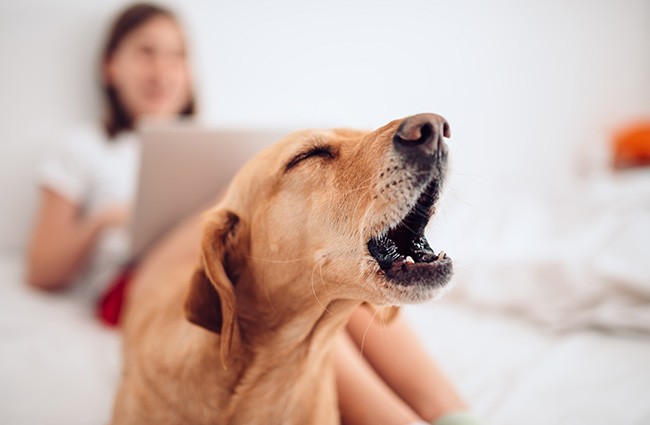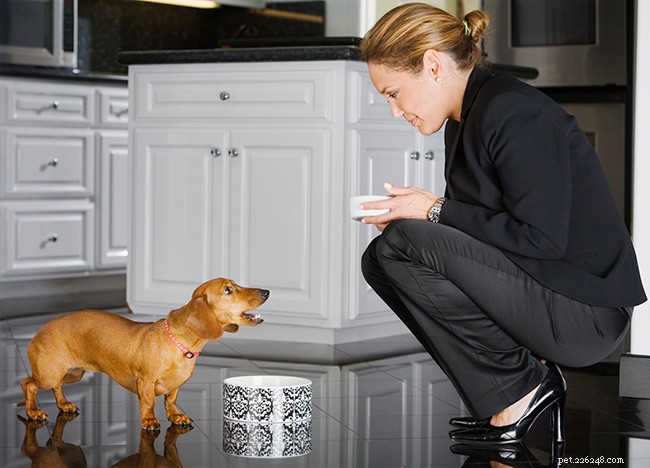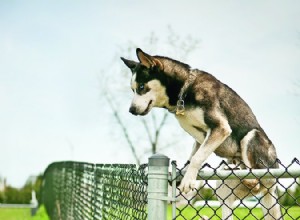
ほとんどすべての犬が吠えます。それは彼らの主要な音声コミュニケーションの 1 つであり、彼らの進化や、危険を察知したときやトイレに出す必要があることを警告するときのように、現代の家の仲間としての役割にも役立ちました.
犬が決して吠えないと期待するのは不合理ですが、その吠えが過度になったり、他の家族や隣人にとって迷惑になったりした場合は、それを抑えるための行動を起こす時が来ました.過度の吠えが家で問題になっている場合、最初のステップは、犬が吠えている理由を突き止めることです。
犬が吠える理由はさまざまで、状況によって意味が異なります。
犬の吠え声:
さまざまな種類の吠え声と、対応が必要な吠え声への対処方法について詳しく説明します。
犬はあなたの注意を引くために吠えることがあります。彼らは、「ねえ、私を見て」、私と遊んだり、撫でたりしています。注意を引くような犬の行動は一般的です。母親の世話に完全に依存する子犬のときにサバイバル スキルとして発達します。
つまり、犬を見たり、話したり、名前を言ったりしないでください。あなたがそれらを認めれば、あなたの犬はあなたの注意を引くことに成功するので、意図せずに行動を助長します.最良の選択肢は、単に部屋から出て、あなたの後ろのドアを閉めて、彼らがついてこないようにすることです. 2 ~ 3 分間部屋から出て、戻ってきたら数分間は注意を払わないでください。
特に長い間成功している場合は、この注意を引く戦術から犬を解放するのに数週間、またはそれ以上かかる場合があります。辛抱強く一貫性を保つことで、犬は吠えが注意を引く効果的な方法ではないことを学習します。
あなたの家や庭を通り過ぎる人に犬が吠えるとき、彼らは潜在的な脅威であると認識していることをあなたに警告しています.それを脅威と考えていても、犬は家族を守るために常に本能に従って行動します。彼らが吠えたときにイライラするのではなく、彼らが「危険、危険!」と言っていることを理解するようにしてください。
彼らの警戒する吠え声にフラストレーションを込めて対処すると、あなたが不安を発散させているので、吠え続ける必要があるという彼らの信念が強まるだけです。あなたの犬が本当にストレスを感じており、あなたを守るために家族の一員としての仕事をしようとしていることを理解して、冷静に対応することが重要です.
<強い> 
1. 最初の吠え声の後 – 「ありがとう」と言い、あなたの犬の名前を使用して、あなたが彼らに反応していることを犬が理解できるようにします。私たちの文化では、穏やかで感謝の気持ちを込めて「ありがとう」と言うように教えられてきたので、これらの言葉を使って応答することが重要です。これにより、犬は助けようとしているだけであり、口調は落ち着いていることを思い出すことができます。これは、応答するときに特に重要です。 If your dog stops barking after this, you don’t need to go to the next step.
<強い>2. Wait 20 seconds after saying ‘Thank You.’ If your dog is still barking, this means that they are still concerned about the danger. Don’t acknowledge them, walk over to the window they are barking at, look through the window as if you are checking out the potential threat. Then turn around and yawn without acknowledging your dog. This shows your dog that there is nothing to worry about. Go back to what you were doing.
3. Wait 30 seconds, and if your dog continues to bark, this means they don’t believe you are capable of making that decision and still feel responsible for making the danger go away. Without making a fuss, slip a leash over their head and calmly take them to another small room, preferably a bathroom or laundry room. If they are afraid of the bathroom or laundry room, use a different place for a time out. Puppy proof the room, turn on the light, and if you are concerned about your dog scratching on the door, put some cardboard or plywood in front of the door before you close it. Remove the leash and leave your dog in the room for three minutes. This gives your dog a chance to calm down and is a reminder that it’s not their job to protect you. If they are scratching, barking or whining, wait for a 10-second pause, then open the door and let them out of the room. Again, don’t give them any special attention.
If there is more than one dog in your home, and both dogs are still barking after step two, the dog who initiated the alert barking goes to a time-out. If the second dog stops after taking the first dog to his time out, you don’t need to do anything. But if the second dog continues barking, they are put in a different room for three minutes.
Your dog will ALWAYS bark to alert you of a threat; it’s in their nature. By following these three steps, your dog will understand that you are in charge and they don’t need to worry. These actions are based on how dogs think and perceive leadership, and after time they will be less intense in their barking and will stop more quickly.
With patience and consistency in your response, your dog shouldn’t escalate to the time outs.
Some dogs will bark to announce, “I need to go potty.” It’s always essential to honor your dog’s request to eliminate.
If your dog barks for this reason, try to appreciate your dog’s call for help, as they are communicating a need in the best way they know how. Calmly walk over to the door and let them out to go potty.
Dogs may not bark when they need to go. They may just stand by the door or circle, pace, whine or paw at the door. Even without barking, let them out regularly to avoid any accidents or discomfort.

While it may seem cute that your dog is ringing the dinner bell, so to speak, this behavior can be a sign of underlying stress.
If you feed your dog when they demand it, whether by barking or other attention-getting behaviors, your dog will believe that they are in charge of the food. This can lead to behavioral issues such as:
The easiest way to address this behavior is to ignore their demand to be fed. Wait until they have stopped trying to get your attention for a while, then feed them. I also recommend changing up their mealtimes by 1 ½- 2 hours. Creating a two-hour window, whenever possible, breaks the habit of your dog expecting to be fed at a particular time in your routine. Eventually, they will stop demanding to be fed, and instead of being woken up by your dog earlier than you’d like, you will be able to sleep in!

When multiple dogs live in a home, they will sometimes bark at each other to communicate that they want all of the attention. For example, one dog may be getting some affection, then another dog comes over to get attention, and the first dog warns the second dog to back off with a bark. This can be a sign of possessive behavior towards the human and must be addressed.
You must decide when affection is given, especially with multiple dogs in the home, so that one dog doesn’t monopolize your attention. If you allow one dog to push the other dog or dogs out of the way, it can lead to the other dogs feeling like they are walking on eggshells. This can lead to other behavioral issues. You should be able to call a dog over to you without either dog reacting negatively.
If your dog exhibits this behavior, it’s helpful to have a leash attached to their collar for easy access so that you can address the action quickly. Of course, you need to ensure that someone is monitoring the dog, so they don’t get tangled in the leash and hurt themselves. If the possessive dog shows signs of telling another dog to back off as you or another family member are giving them attention, they need to be immediately and calmly removed from the room. Step on the leash, don’t look at or talk to the dog, remain calm and matter-of-fact in your energy, and pick up the leash.
Then, escort the dog to the bathroom or laundry room to be separated from everyone. Turn on the light, remove the leash, and leave them alone in the room for three to five minutes. After three minutes, open up the door, put the leash on, with no acknowledgment, and let them out. If they are barking, whining, or scratching on the door, it’s crucial to wait for a 10-second break in the barking, whining or scratching, then open the door. If not, they will think they were let out because they were complaining, and that reaction will escalate.
Some dogs need to be walked on a leash back into the room with the other dogs, or they could go straight to the other dog and lunge again. Don’t drop the leash until the dog’s energy is calm and relaxed. You set the room’s tone by creating as much safety and calm energy as possible, bringing the stress level down, making it easier for the dogs to feel relaxed.
If they have separation anxiety, three minutes is adequate. You don’t want them to get stressed being separated for too long. However, if the dog is assertive and confident, they usually require four to five minutes of separation to digest the message.
The reason for separation is that dogs understand this consequence as if they were part of a pack on the street or in the wild. If they made a mistake in the pack, essentially challenging the leadership, they would be reminded that they were not in charge of making decisions. They would be shunned from the rest of the pack for a while. As they are now living in our homes, we are their pack, so this consequence makes sense to them. When done consistently, we will teach them their behavior is unacceptable.
It’s vital to ensure that you give each dog in your home attention and that they all feel included. By calling them to you for affection, you are showing them that you are in charge of when they receive attention and that one of them isn’t more important or higher ranking than the other.
This allows all of your dogs to feel comfortable and relaxed with you and in general. Remember, even for a dog who may be bullying, they are feeling stressed, or they wouldn’t be exhibiting that behavior.
Dogs can bark to show another dog that they are in charge in other ways:
For any controlling behavior like this, it’s essential that it’s addressed every time and that you don’t let the dogs work it out between them. You must always show that you are in charge and that it’s never OK for any of your dogs, no matter their age, to try to control another dog in the home.
Just like you wouldn’t let kids fight; an adult would step in to resolve the conflict. For any attempt to control another dog in the home, the dog asserting themselves should be immediately and calmly separated for a time out, as previously described.
Once the issue has been resolved, the atmosphere in the home will change:
Dogs use their voice and bark to say “throw the ball!” and to express that they are having fun.
While this is probably the best kind of barking to a pet parent, it’s important that you are in charge of the playtime, meaning that you:
Your dog is in charge of playtime if they:

The easiest way to stop this behavior is simply putting the ball or toy out of sight when you are finished playing the game.
I also recommend adding rules to the game; the more you establish that you are creating the rules for playtime, the less your dog is likely to try to make up their own rules.
For example, if you want to play fetch, ask them to ‘sit’ before you even throw the ball, requiring them to show self-control. Then as you throw it, ask them to ‘fetch’. Once they have picked it up, say, “good fetch, bring it.” If they bring it to you, then say, “good bring it, drop it.”
It’s easier to teach them to drop it, in the beginning, if you exchange the ball for a treat. Once they bring it and you have praised them, hold the treat in front of them, as you ask them to “drop it”. As soon as they drop the ball, pick it up with one hand, as you give them a treat with the other and say, “good, drop it.”
This keeps your dog’s focus on you and what you expect from them to continue playing the fetch game. If they are barking in the joy of the game, but not being demanding, keep playing.
If they start demanding that you throw it, you can walk back inside and put the ball away, ending the game if you like. Another option is to wait until they have stopped barking, then throw the ball. The goal is that you define the rules of the game.
Sarah-Anne Reed is a holistic dog trainer, and owner of Pack Dynamics, LLC ®. Her practice focuses on understanding and respecting dogs as a different species and honoring them as individual beings.
This article is copyrighted by Sarah-Anne Reed and Pack Dynamics ® LLC, and no reproduction of this article without the express permission of Sarah-Anne Reed, is permitted.
Are you someone who takes dog training seriously? Then you are a great candidate for pet insurance. Get a quote and make sure you’re covered for future injuries or illnesses.

責任ある犬の飼い主は、犬の家族が家で安全に過ごし、近所を付き添わずに歩き回らないようにするために、大変な苦労をします。自由に歩き回る犬のリスクには、車にぶつかったり、怒り狂った隣人や公共の安全を守る警察官に撃たれたり、他の動物に攻撃されたり攻撃されたり、動物に拾われたりするなど、さまざまなものがあります。制御、または単に消えて、二度と見られることはありません。それでも、一部の犬は逃げるのにひどく曲がっているように見えます–人間の封じ込め戦略を乗り越えたり、下に置いたり、周りに置いたり、通り抜けたりするために考えられるすべてのことをします。庭から逃げるのに専念している犬がいるときはどうしますか?

これを書いていると、裏庭でケルピー、カイが吠えているのが聞こえます。 。 。なにか。カイは、リス、猫、鳥、馬など、動くものなら何でも吠えます。私は、吠える犬が隣人の確執、動物管理の引用、および民事訴訟のきっかけとなる可能性がある、より近い場所に住む犬の飼い主に共感することができます。そして、私たちの最も近い隣人が半マイル離れており、犬の不協和音の時折の発作について不平を言う可能性が低いことを私の幸運な星に感謝します。 吠えることは自然で正常な犬の行動です。犬を飼っている場合は、犬が吠えることもあることを理解して受け入れる必要があります。 とは言うものの、犬の中には他の犬よりもずっと吠える犬